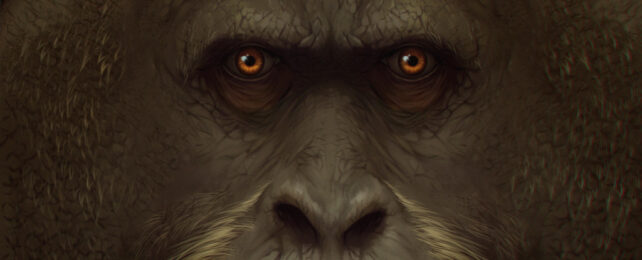The largest ape ever to roam planet Earth didn't stand the test of time, dying out when its smaller peers adapted to environmental change, new research suggests.
Standing around three meters tall, the primate Gigantopithecus blacki could have weighed as much as 300 kilograms (660 pounds). Yet like other megafauna of its time, this gigantic stature rendered G. blacki ill-equipped for increasingly variable conditions other more agile apes such as orangutans adapted to, researchers have found.
Known by four jawbones and a few thousand teeth, the timing and reason for G. blacki's ultimate demise had eluded paleontologists for decades.
"The story of G. blacki is an enigma in paleontology – how could such a mighty creature go extinct at a time when other primates were adapting and surviving?" explains paleontologist Yingqi Zhang from the Chinese Academy of Sciences, who co-led the study.
To sketch the details of that extinction story, Zhang and colleagues reconstructed the environment G. blacki lived in some 2 million years ago when the primate first appeared in the fossil record, and those of the late middle Pleistocene when it went extinct.
They analyzed fossils and sediment samples from 22 caves in southern China, half of which contained remains of G. blacki. Put together, those fossils represent the largest collection of evidence of G. blacki, spanning its entire range.

While fossil records can't definitively tell us why a species died out, pinpointing when a species disappeared can help researchers narrow in on periods of environmental and behavioral change that paralleled its extinction.
"Without robust dating, you are simply looking for clues in the wrong places," says Macquarie University geochronologist Kira Westaway, who co-led the study with Zhang.
Zhang, Westaway, and colleagues estimate that G. blacki went extinct between 295,000 and 215,000 years ago, based on 157 radiometric dates they generated using six different dating techniques.
Pollen analyses revealed that just before and by the time of G. blacki's demise, the forests of southern China had shifted from conditions that suited G. blacki well, such as dense forests with heavy canopy cover, plentiful water, and ample fruit, to drier landscapes with more open forests, fire-prone grasslands, and increased seasonality.
This climatic variability was G. blacki's undoing. Compared to its closest known primate relative the also-extinct Chinese orangutan (Pongo weidenreichi), G. blacki didn't adapt well to environmental change, dental analyses showed.
G. blacki teeth had signs of chronic stress as the species neared its end, and its diet also became less diverse as forests opened up and dried out. Population numbers dwindled and G. blacki's geographic range shrank.
"This is the first insight into the behavior of G. blacki as a species on the brink of extinction, which is in stark contrast to P. weidenreichi that shows much less stress at this time," the researchers write in their paper.
It's not that G. blacki became more exposed or threatened in open forests, the researchers note, but rather the ape depended on nutrient-rich fruits which became scarce as the forests changed.
"G. blacki was the ultimate specialist compared to the more agile adapters like orangutans, and this ultimately led to its demise," Zhang says.
Fateful as this environmental change was for G. blacki, researchers think there is a lot to learn from its story about primate resilience to changing climates, in the past and future.
"With the threat of a sixth mass extinction event looming over us, there is an urgent need to understand why species go extinct," Westaway says.
The study has been published in Nature.
